So many engineering marketers want their campaign to reach decision makers. Their thought process goes something like, “If I can just get our product in front of the decision makers, we’ll generate high quality leads and a ton of conversions, because our product is a perfect fit for [insert name of industry/application here].”
But how do you reach those decision makers? Do they prefer:
- Long articles or short?
- Print or digital?
- LinkedIn or Facebook?
- Sponsored posts or editorial?
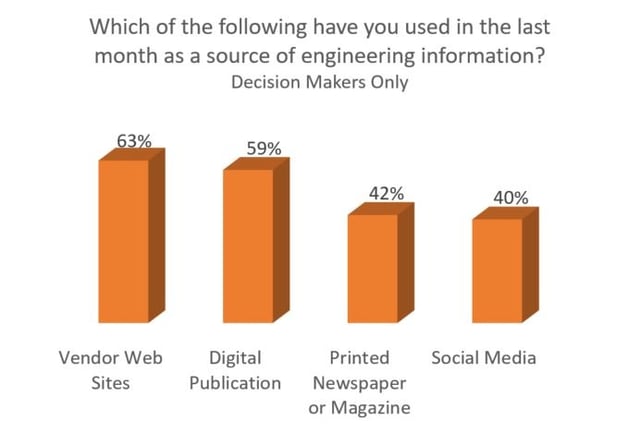
I’m happy to report that we can now tell you the answers to these questions. That’s because last month we conducted a survey of 1,187 engineers to learn about how they consume media. We’ll share our findings for all classes of engineers with you in an upcoming webinar and eBook, but today we’re focusing on just the people deciding where their company is going to spend.
Of those 1187 respondents, 110 said that they were the final authority in the purchasing decision making process for their company.
In this post, we’ll dig into how those people consume engineering content.
Let’s first confirm a few biases about decision makers. Yes, they are older and they have titles like CXO.
We asked everyone in the survey what decade they were born. Not surprisingly, decision makers skewed older than the average engineers. The chart below shows that the peak population of decision makers is in the 46-55 year age range, with the next most populous ages being 56-65 and 65+.
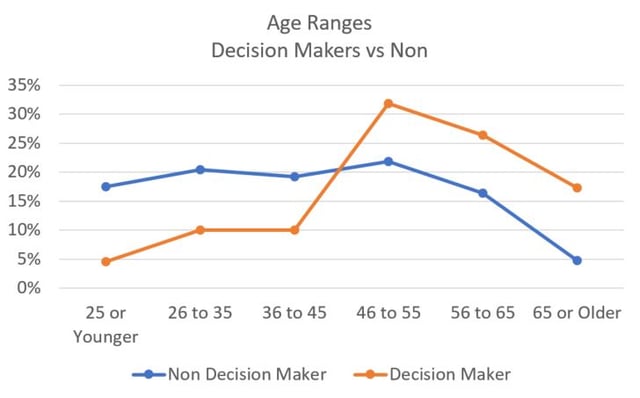
This contrasts with the non-decision makers who skew younger. The 46-55 age range is still the most popular at 22% of the sample, but the overall sample is much flatter and younger.
Similarly, job roles also confirm what you would expect when comparing decision makers versus non-decision makers.
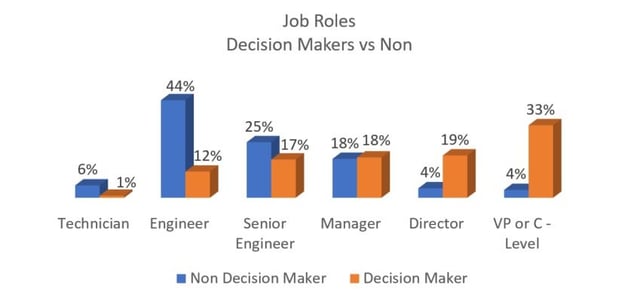
The chart shows that decision makers are more likely to have titles like “manager” “director”, “VP” or “CXO”, while non-decision makers are more likely to have titles like “engineer” or “Senior engineer”.
Do decision makers prefer long articles or short ones?
When you are an engineering marketer, a lot of your budget and energy goes to creating content for your target persona(s). So, when you are writing something for a decision maker, how long should it be? Is it true that you should use an “executive summary” for executives?
The chart below shows the frequency with which decision makers said that they would read short versus long articles. The chart is arranged from less frequently on the left to most frequently on the right. For example, on the left side of the chart you can see that 3% of decision makers said that they would never read short articles and 10% said that they would never read long articles.

The chart shows clearly that short articles win out over long articles when it comes to how frequently engineering decision makers will read them. You can see that in all the higher frequency time frames, from weekly to multiple times per week to daily, decision makers show a strong preference for short articles.
That doesn’t mean that there isn’t a role for longer form articles, just that you can’t expect decision makers to set aside time to read them very often. Therefore, if you are planning a content series for decision makers, you would do well to edit your text until you are sure that every word counts, and to include longer form content sometimes, but probably use that format for less than 20% of your stories.
Do engineering decision makers prefer print or digital?
We asked engineering decision makers how much time they spend consuming engineering information in an average week. They told us that they spend a ton of time. The average decision maker said that they spent 9.9 hours consuming content each week.
The following chart shows the time spent by device. You can see from the chart that a laptop or computer is a decision maker’s preferred device for consuming engineering information. Those who use a computer reported an average of over 4.6 hours per week consuming engineering information on that device.
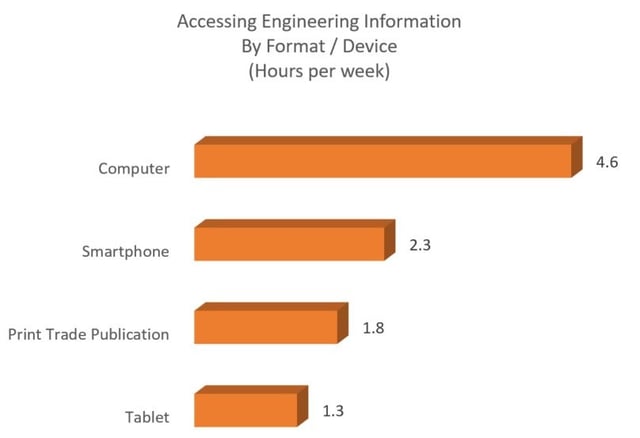 Do decision makers prefer LinkedIn, Facebook or Twitter?
Do decision makers prefer LinkedIn, Facebook or Twitter?
If you are wondering which social media distribution channel works to reach decision makers, LinkedIn is the clear winner. The chart below shows that decision makers prefer LinkedIn to Facebook or Twitter by a margin of 3:1 when it comes to sourcing engineering information.
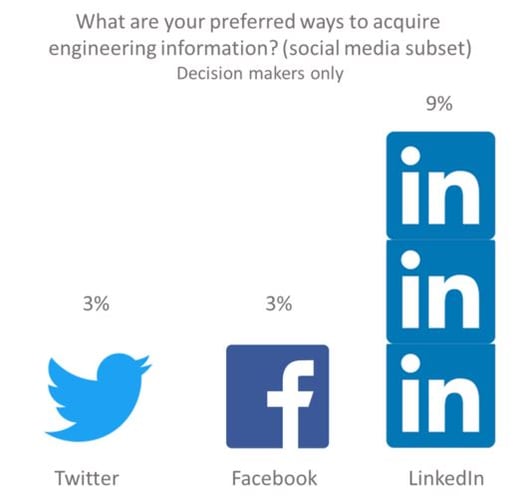
The bigger story here, however, is that none of these social media distribution channels alone are likely to reach very many decision makers. Even LinkedIn was only mentioned by 9% of decision makers as a preferred source of engineering information.
That said, while they may not prefer social media as a source of engineering information, it still reaches them. In the chart below, you can see that 40% of decision makers said that they consumed engineering information over social media in the past month.
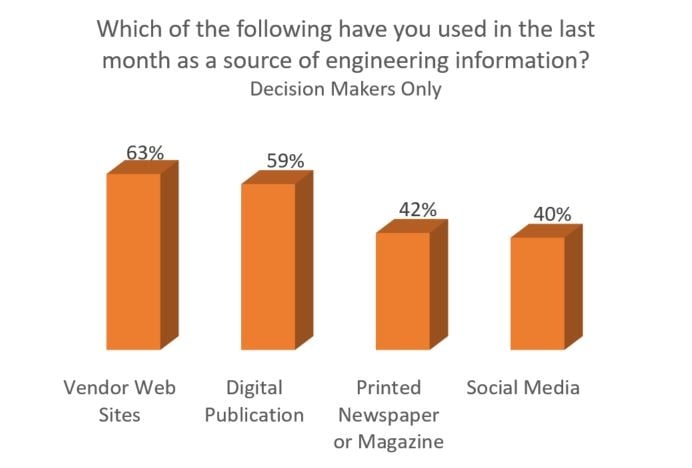
Note that their most common sources of engineering information were vendor web sites and digital publications at 63% and 59% respectively. You all know that ensuring that your web site is the best source of information about your products that it can possibly be is effort well spent. It is also worthwhile to note that making sure that your stories are told in publications is almost equally important.
How do decision makers process sponsored stories?
Changing gears for a moment, we asked how decision makers engage with sponsored stories. The reason we ask is that prior surveys have revealed that sponsored stories are general popular with our audience. The viewership and engagement metrics (likes, shares, etc.) tend to be very strong across all readers, so we wanted to see whether decision makers were any different.
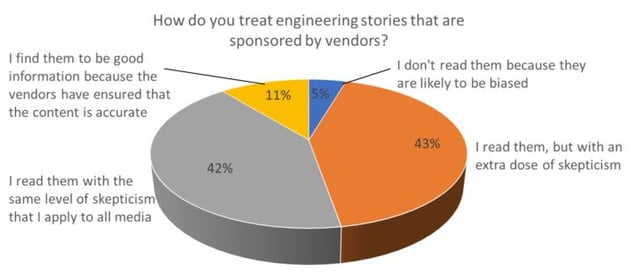
As it turns out, only 5% of decision makers said that they don’t read sponsored stories. Most (85%) said that they do read sponsored stories, albeit sometimes with a little more skepticism. Another 11% said that they find sponsored stories to be good quality information because the vendors have fact checked the stories to ensure that the content is accurate.
In closing
I’ve thrown a lot of data at you here, and I hope that you found it to be an interesting view into the world of decision makers. To summarize, here is a check-list of questions to ask yourself next time you’re building a campaign for decision makers:
- Is the language and supporting imagery age-appropriate for Decision Makers (no Rick and Morty references no matter how badly you want to make one)?
- Are your stories the right length with all extraneous text eliminated?
- Do you have a plan to get your stories into the digital (and print) publications that they read?
- Do you have sponsored content ready to go so that you’re getting decision makers who haven’t yet thought about, considered, or have even heard of your product?
- Are you hitting the right social networks? If decision makers are 3x as likely to prefer LinkedIn shouldn’t you be 3x as willing to spend?
Until next time,
John




